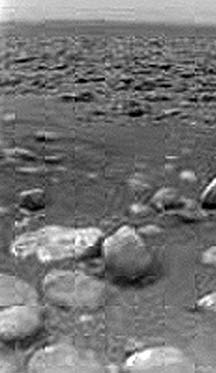Saturn’s moon
reported to be frozen
version of Earth
WASHINGTON » Data from the Cassini-Huygens spacecraft suggest that Titan, a moon of Saturn, is a world with the potential of life that was frozen in its youth, prevented by deep cold from ever developing into a livelier place.
![]()

This image was taken by a probe on Titan, part of a joint U.S.-European mission.
Titan's minus-290 degree Fahrenheit temperature prevented the chemical reactions that are thought to have occurred on Earth, possibly leading to the evolution of life, said Owen, one of a group of researchers presenting papers on Titan at the national meeting of the American Association for the Advancement of Science.
"All of the elements that we are made of are there," Owen said Friday, "but all of the water is frozen solid. There's no oxygen available. If it could warm up, it would be beautiful."
Ice appears to form the bedrock of Titan, he said, and there is some suggestion of cryovolcanoes, volcanic-like vents that spew ice instead of lava. Owen said features detected by the Cassini spacecraft orbiting Titan show channels resembling Earth's volcanic features, but they may have been carved by creeping ice, not molten rock.
Owen said the evidence for ice volcanoes on Titan is "shaky," but it is the leading theory to explain some of the features seen on the body.
"We're not expecting to find life on Titan. It's just too cold," said Owen. "But we expect to find the primordial ice cream" -- the complex of chemicals that could possibly be the precursors to life.
Cassini-Huygens is a joint NASA-European Space Agency project. The combined craft was launched in 1997 and arrived in orbit of Saturn last year. Huygens, a lander developed and controlled by the ESA, touched down earlier this year.
Early studies show Titan is covered with pools of methane, an organic chemical maintained on the surface by deep cold.
Owen said that Huygens apparently landed in a "mud" formed by methane and that heat from the craft created a cloud of the gas that instruments quickly analyzed and identified.
Titan's intense cold and atmospheric pressure -- about 1 1/2 times that of Earth -- keep methane in a liquid state. Researchers earlier said there are methane showers on Titan and a methane fog.
Methane is a highly flammable gas, but there is no free oxygen on the moon to support combustion. Instead, methane flows and showers and pools.
"Methane takes the role that water does on Earth," said Owen. "And ice is like sand." He said in Titan's intense cold, chips of ground ice could be like beach sand, drifting with the flow of methane.
Dennis Matson of NASA's Jet Propulsion Laboratory said that ice forms the bedrock of Titan and that sometime during the formation of the moon the frozen water may have warmed enough to flow to the surface like lava on Earth.
"It would be the consistency of magma. At some temperatures below freezing, ice is pliable," he said. "It could flow like toothpaste out of a tube."
[News] [Business] [Features] [Sports] [Editorial] [Do It Electric!]
[Classified Ads] [Search] [Subscribe] [Info] [Letter to Editor]
[Feedback]
